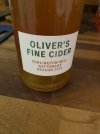- Location
- London
Just enjoying a bottle of this rarer than the Hainan black crested gibbon cider, made by Tim Phillips of Charlie Herring wines. It's an astonishing thing, the very last word in subtlety in a drink for which that is not usually a notable quality, but without any suggestion of attenuation. It is not made in the champagne manner , as most ambitious ciders seem now to be; on the contrary it is entirely still and bone, bone dry, which for me is the sine qua non of cider, and there is nothing remotely showy or ostentatious about it, the maturation on riesling skins and the addition of hops showing themselves mostly in the extraordinary midpalate depth and long, long finish. I haven't tried yet but I suspect this will go with almost anything with which wines struggle, and since I suspect that production can't be hugely increased it would seem like a good idea for people to start copying it. I could drink a bottle of this every day forever and die happy but it's certainly a drink for those who adore cider rather than those who can take it or leave it.





